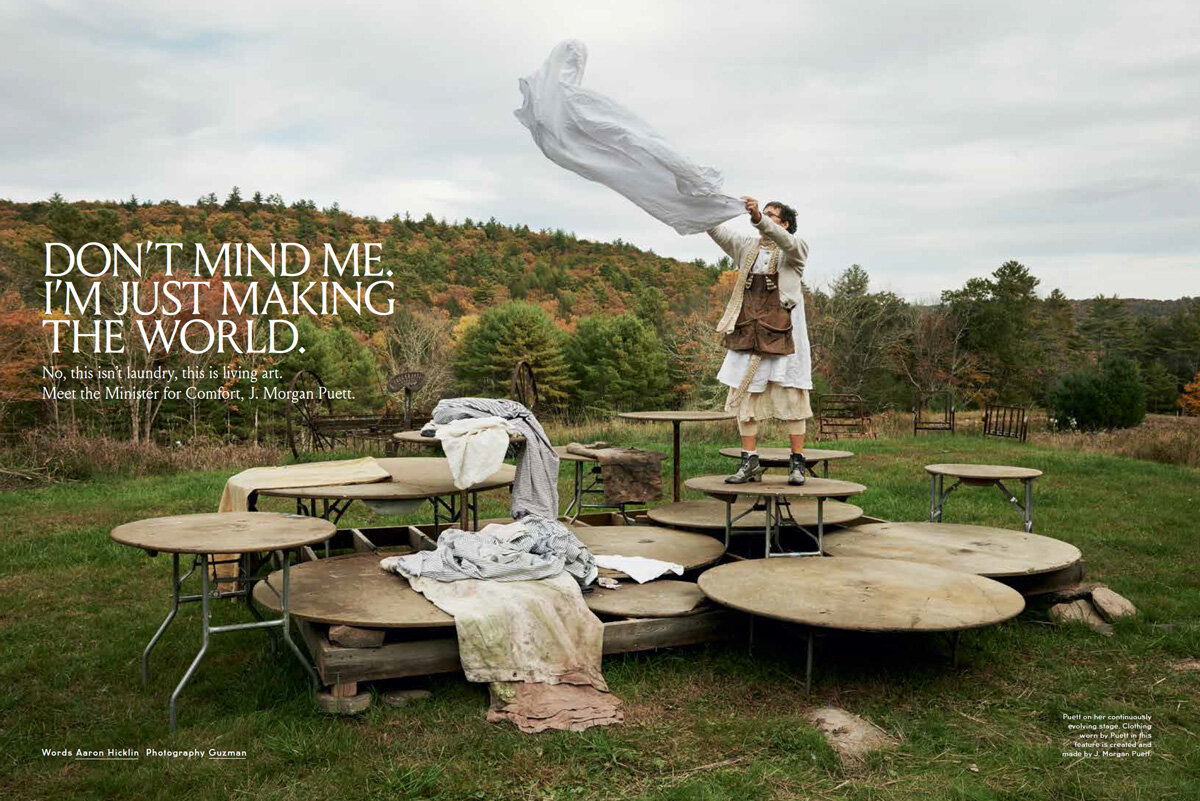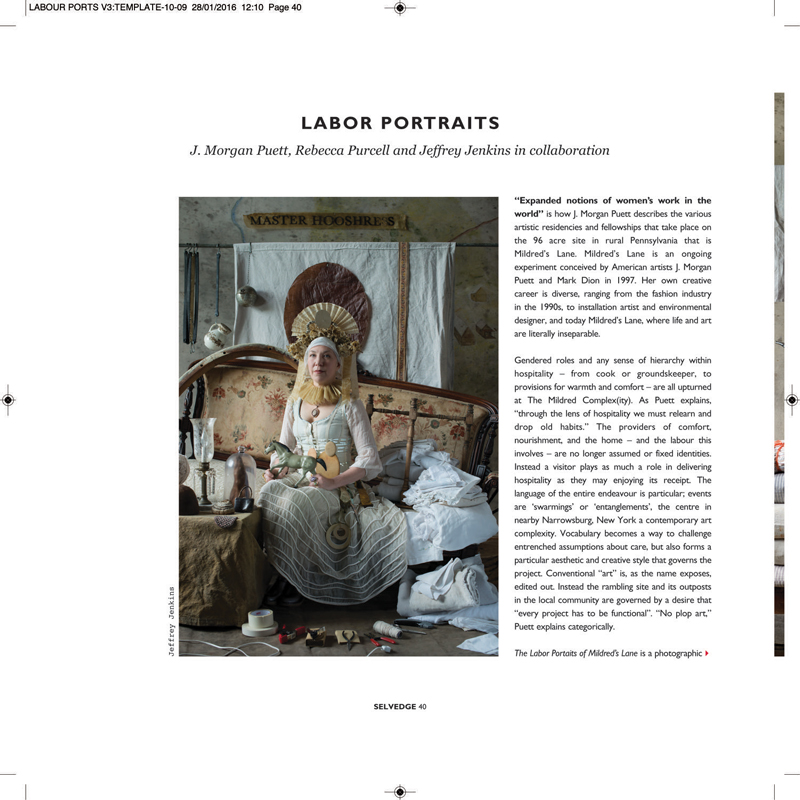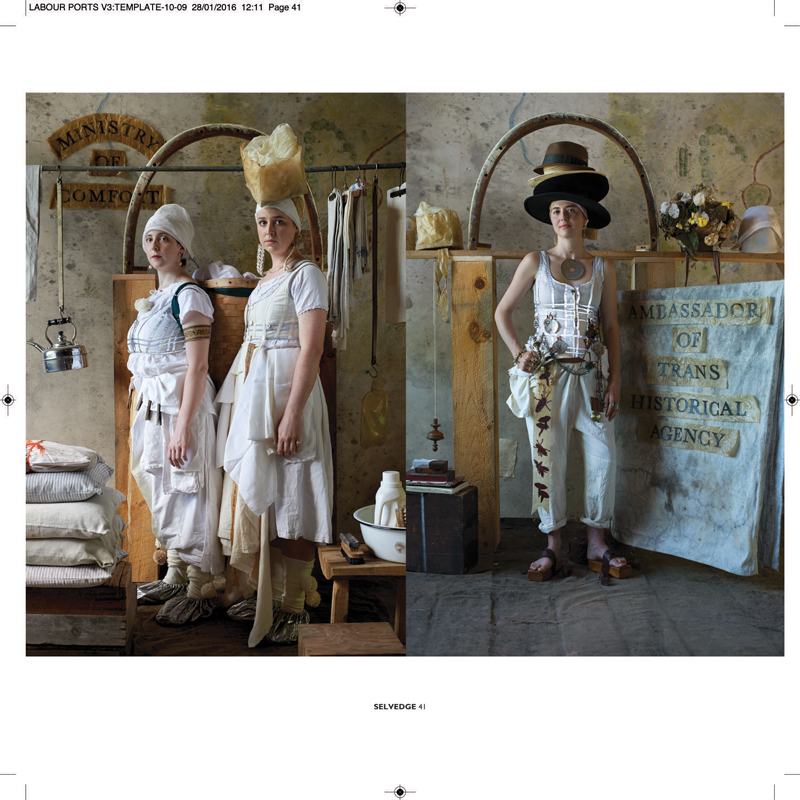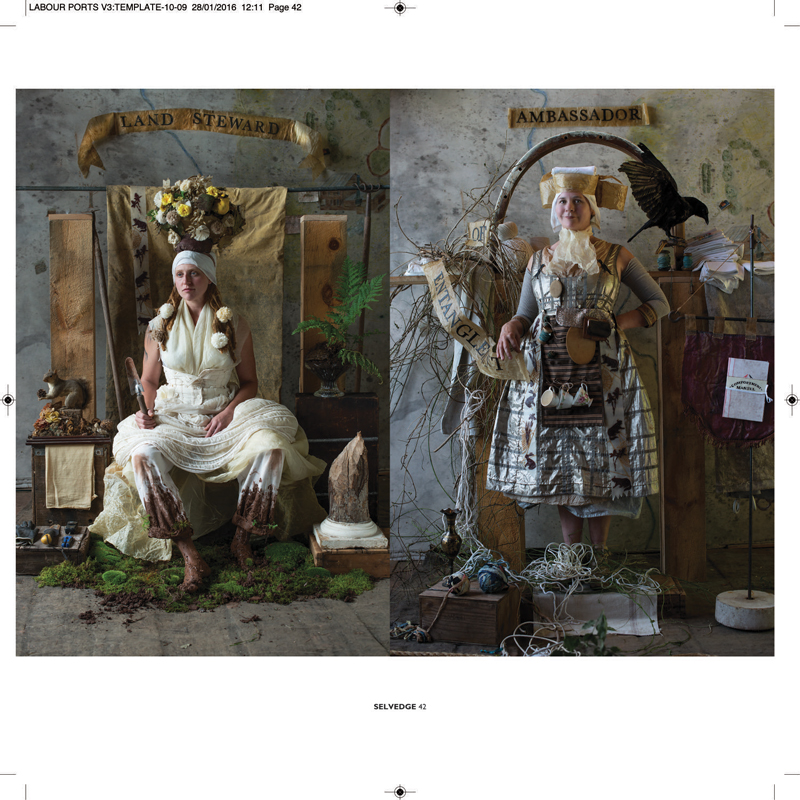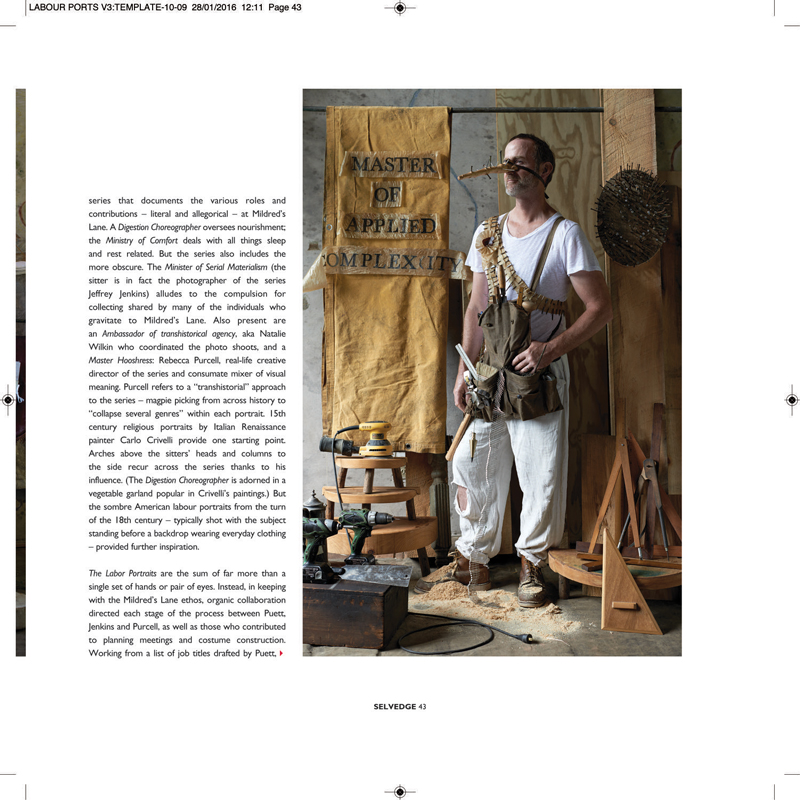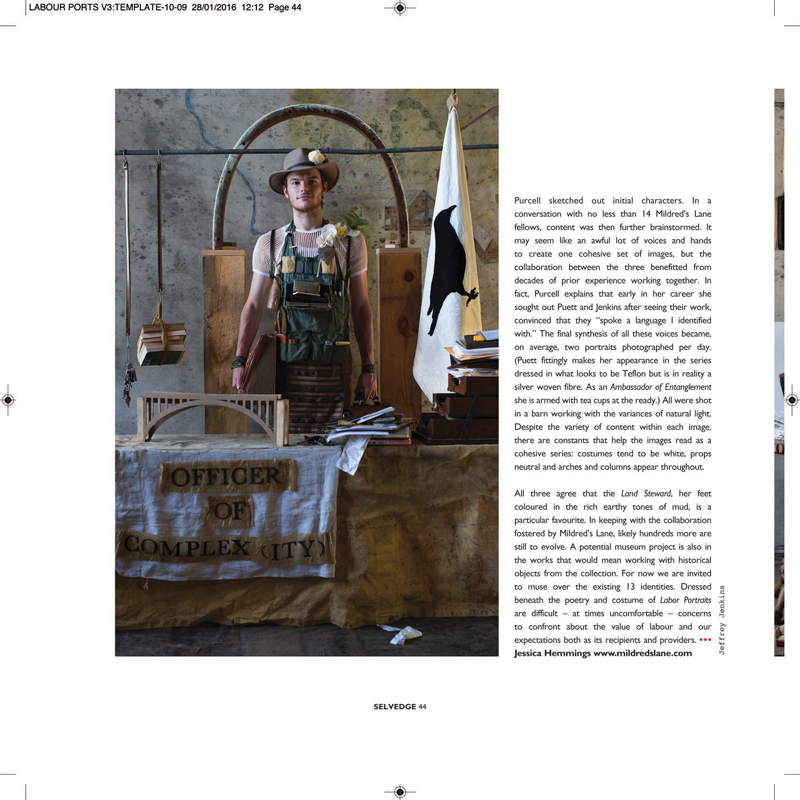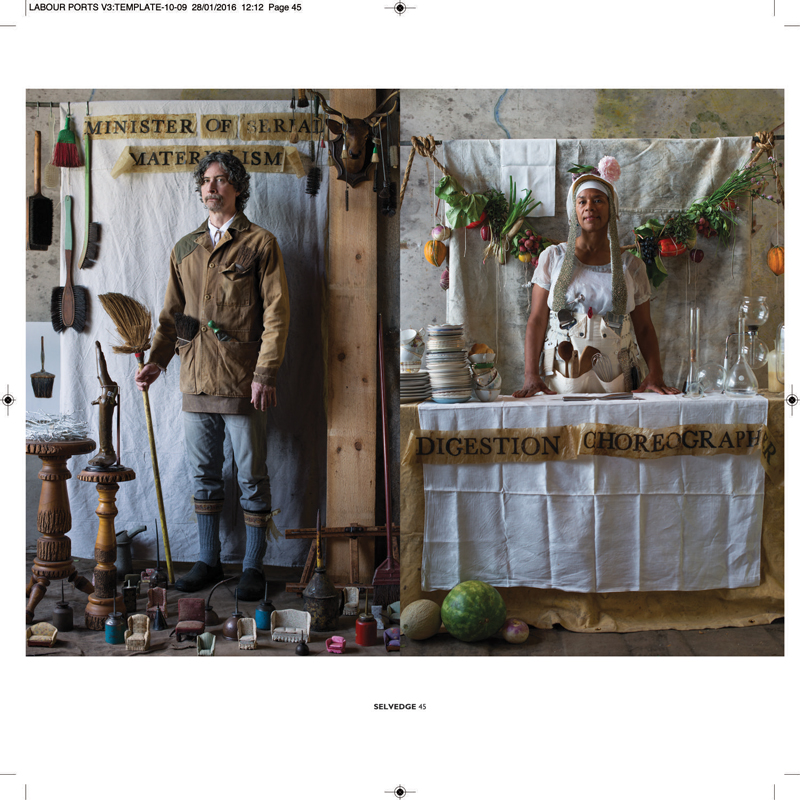Making Home | Women Artists Redefining the Domestic
Making Home
Women Artists Redefining the Domestic
A conversation inspired by artist and Stone Quarry Art Park founder, Dorothy Riester.
Moderated by Stone Quarry and generously hosted at the offices of
Robert A.M. Stern Architects (RAMSA)
One Park Avenue, New York, NY 10016
Thursday, October 10, 2024
6-8 PM
RSVP here: bit.ly/3TglpXi
Featuring
Ann Agee, Jessica Arb Danial, Portia Munson, J. Morgan Puett, Michele Oka Doner
For questions, contact Emily Zaengle
emily@sqhap.org / (315) 525-7745
No cost to attend. Open to the public.
Registration required for building access.
Architectural Digest - Take a Perfect Weekend Trip to Narrowsburg
New York Journalist Aaron Hicklin offers up his 9 favorite local spots
Mildred’s Lane“This is the most radical thing in the Catskills, period. Artist J. Morgan Puett, who just won a Guggenheim fellowship, her friend Mark Dion, and their son, Grey Rabbit, have turned this 94-acre plot of land into a magnet for artists and architects, who collaborate on environmental and domestic projects. I’ve been to dinner there, and even tried mimicking Morgan’s hyper-artistic approach to curating her refrigerator as if a piece of art.” 37B Main Street, Narrowsburg, New York; mildredslane.com
ARTFORUM / On Site
image / Views of Mildred's Lane, Beach Lake, PA. Kitchen Laboratory, 2018. Photo: Robyn Lea.
... Mildred’s Lane is not a product to be consumed or an “experience” to be Instagrammed. It is a link in a larger countercultural chain that, like the variegated ecosystems of the property, may be critically endangered.
Read the article /
ARTFORUM / ON SITE
GOOD HOUSEKEEPING
Ian Bourland on Mildred’s Lane
Please DONATE / Help Protect Mildred's Lane
. . . . . . . . . . . . . . . . . . . . . . . .
The Brooklyn Rail in conversation with Mildreds Lane
Mildred’s Lane
Featuring J. Morgan Puett, Mark Dion, David Brooks, Alastair Gordon, Barbara Bourland, and Thyrza Nichols Goodeve
Ambassador of entanglement J. Morgan Puett is joined by Mark Dion, David Brooks, Alastair Gordon, Barbara Bourland, and Thyrza Nichols Goodeve for a conversation on Mildred’s Lane. We conclude with a poetry reading by Patrycja Humienik.
In this talk
Read more about Mildred’s Lane on their website »
J. Morgan Puett
Trans-disciplinary creative producer J. Morgan Puett works with installation, clothing and furniture design, architecture, film, photography, and more, rearranging these intersections by applying conceptual tools including research-based methods in history, biology, new economies, design, textiles, and collaboration. Puett is the architect of The Mildred’s Lane Project, which continues to forge new ground citing that being is a profoundly social and political practice. Puett has received several awards, including the Magdalena Abakanowicz Arts and Culture (2019), the John Simon Guggenheim Memorial Foundation (2016), the Pollock-Krasner Foundation (2016), among many others.
More on J. Morgan Puett
Mark Dion
Artist Mark Dion’s work examines the way dominant ideologies and public institutions shape our understandings of history, knowledge, and the natural world. The job of the artist, he says, is to go against the grain of dominant culture, to challenge perception and convention. Appropriating archaeological, field ecology and other scientific methods of collecting, ordering, and exhibiting objects, Dion creates works that question the distinctions between ‘objective’ (‘rational’) scientific methods and ‘subjective’ (‘irrational’) influences. Dions holds a BFA and an honorary doctorate from the University of Hartford School of Art, Connecticut. He is a cofounder and co-director of Mildred’s Lane. He was born in New Bedford, MA in 1961.
David Brooks
Artist David Brooks' work considers the relationship between the individual and the built environment, considering how cultural concerns cannot be divorced from the natural world while questioning the terms under which nature is perceived and utilized. He has exhibited at the Aldrich Contemporary Art Museum, CT; the Dallas Contemporary; Tang Museum, NY; Nouveau Musée National de Monaco; Sculpture Center, NYC; The Visual Arts Center, Austin; Nevada Museum of Art; and MoMA/PS1, among others. He is the recipient of several prestigious awards and grants including the Rome Prize, grants from the Foundation for Contemporary Arts, the Coypu Foundation, and a Smithsonian Artist Research Fellowship. Born in Brazil, Indiana, he currently lives and works between New York City and New Orleans.
Barbara Bourland
Writer Barbara Bourland is the author of two previous novels and an avid Mildred’s Lane Bibliophant. Her third novel The Force of Such Beauty is forthcoming from Dutton in Summer 2022. She lives and works in Baltimore, MD.
Alastair Gordon
Critic, curator, artist, and cultural historian Alastair Gordon has covered art, architecture, and the environment for the New York Times for more than twenty years and is Contributing Editor on design for the Wall Street Journal Magazine. His essays have been published in Architectural Digest, Vanity Fair, Le Monde, and others. He is the author of Weekend Utopia: Modern Living in the Hamptons(Princeton Architectural Press 2001), Naked Airport: A Cultural History of the World’s Most Revolutionary Structure (University of Chicago Press 2004), and Spaced Out: Radical Environments of the Psychedelic Sixties (Rizzoli 2008). In 2016, he launched Poetics of Place, a critical writing program at Harvard University’s Graduate School of Design.
Thyrza Nichols Goodeve
Writer, editor, artist, and interviewer Thyrza Nichols Goodeve writes “with” rather than “on” contemporary art and artists. Her interests range across art as a “structure of feeling,” human/nonhuman animal ontologies, the aesthetics of wonder, the interview as essay, surrealist methodologies, and the metaphysics of technology. She has published widely on artists such as Ellen Gallagher, Tom Friedman, Hadieh Shafie, Joan Waltemath, among many others. She is the author of How Like A Leaf: A Conversation with Donna Haraway (1999) and is compiling her collected writings, No Wound Ever Speaks for Itself: Writing, Art, Vulnerability, Conversation, Attitude with a preface by Avital Ronell. She was Senior Art Editor at the Rail from 2017 to 2019 and is currently an Editor-at-Large.
In the Rail: Thyrza Nichols Goodeve
The Rail has a tradition of ending our conversations with a poem, and we’re fortunate to have Patrycja Humienik reading.
Daughter of Polish immigrants, Patrycja Humienik is a writer and performer based in Seattle, WA. She serves as Events Director for The Seventh Wave and works in the Office of Equity & Justice in Graduate Programs at the University of Washington. She was a recent semi-finalist for the 92Y Discovery Prize, and is working on her first book of poems, Anchor Baby.
More on Patrycja Humienik
Reassembling Time: The Alternative Pedagogy of Mildred’s Lane
Standing in front of the unfinished Alchemist’s Shack with artist and Mildred’s Lane codirector J. Morgan Puett, I realized that some things can take forever. An art installation-cum-habitation, the shack has been a work in progress for Puett, artist and codirector Mark Dion, artist Robert Williams, and the countless participants who have visited Mildred’s Lane for nearly twenty years.
Mildred’s Lane Main House and session field study. Photograph courtesy of Mildred’s Lane.
Standing in front of the unfinished Alchemist’s Shack with artist and Mildred’s Lane codirector J. Morgan Puett, I realized that some things can take forever. An art installation-cum-habitation, the shack has been a work in progress for Puett, artist and codirector Mark Dion, artist Robert Williams, and the countless participants who have visited Mildred’s Lane for nearly twenty years. Over a two-week summer 2016 session, Williams worked with several Mildred’s Lane fellows to complete the installation’s rustic exterior and create a Wunderkammer inside filled with gold and silver skeletons, Williams’s hand-blown glass scientific instruments, antique books, and other alchemical accoutrements. The fellows supplemented physical labor with texts about the history of alchemy and how it might be applied to contemporary art practices. Over the course of this session, the parties involved might finish the Alchemist’s Shack, or they might not. That’s fine, of course, because everything is incremental at Mildred’s Lane.
Mildred’s Lane is neither a residency nor a retreat, but a Gesamtkunstwerk. It is a site of perpetual reinvention and growth, a pedagogical experiment, and a “style of poetics,” to quote Puett. She estimates that the origins of the Mildred’s Lane property go back to the 1830s when it was settled as a homestead. Mildred Steffens was born there in 1902 and lived all eighty-six years of her life on the property. Steffens’s family had immaculately cared for the place before selling the property to Puett and Dion in 1997. “It was as if Mildred had just walked down the lane,” recalls Puett, who lives there year round with her and Dion’s son, Grey Rabbit. Puett and Dion began their art-as-living project informally with the help of friends, slowly building out the main edifice and satellite buildings around the property brick by brick, grant by grant, eventually growing Mildred’s Lane to ninety-six acres. Every aspect of the property is designed to evoke a pastoral yet elegant aesthetic. Taxidermic animals adorn every nook, steel-paneled walls are patinated in umber, and Puett meticulously stained the bathroom with a convincing faux-creep of mold. (There is Wi-Fi and electricity because “we live in the twenty-first century, after all,” Puett told me.) “Much like zen practices,” former fellow and visiting artist Donna Cleary explains, “Morgan’s work is about the intention behind every act [so] that each act has purpose, aesthetic value, and care embedded in it.”
Nils Norman lecturing in the Mildred’s Lane Barn Lyceum. Photograph courtesy of Mildred’s Lane.
As both a total work of art and a form of alternative pedagogy, the Mildred’s Lane program pushes the limits of what art can do beyond perpetuating its own discourse. “We take the three-letter word [art] out of it,” Puett remarks. Dion understands Mildred’s Lane as a place that preserves the kind of education he had in the 1980s, in which “the pub was a pedagogic space.” Since 2007, hundreds of fellows—artists, writers, graduate students—have attended one of the three to six recurring or unique sessions each summer on truly diverse (and enigmatic) topics. Summer 2016 sessions included “Attention Lab,” “Pond,” and “TOWN.” Puett views Mildred’s Lane as an opportunity for passers-through to rethink everyday habits, in order to “maximize your experience of everything” in a way that “reassembles every bit of you.” Outside of what Dion describes as today’s “stifling academic structures,” the education system is carefully curated to encourage freedom and self-realization, all of which is complemented by “a lot of productive hanging out.” Purposefully eluding narrow definitions, Mildred’s Lane is, according to Puett, a “complex(ity).”
Puett and Dion encourage fellows to embrace a new lexicon for art and life that operates outside of established speech. This is crucial to the experience of Mildred’s Lane. It takes an afternoon or so to acclimate to these creative reimaginings of bureaucracy, domestic labor, and self-identification. For instance, Puett is not the director of Mildred’s Lane but the “Ambassador of Entanglement.” Dion is the “Cabinet Minister Peregrinator.” Cesar Valdes was this summer’s “Ministry of Comfort,” an artist-in-residence of sorts who tracks the satisfaction levels of fellows and guests by creating a work of art in the form of a drawing, diagram, craft object, or sculpture called the “comfortometer.” Paul Bartow is not just an architect and designer, but the “Master of Applied Complex(ity).” Cheryl Edwards is the “Digestion Choreographer” (eating, and eating well, is central to the experience of Mildred’s Lane). Indeed, if everything in our world is administered and managed, then why not do so artfully?
Digestion Choreographer Cheryl Edwards from “The Labor Portraits of Mildred’s Lane” courtesy of J. Morgan Puett, Rebecca Purcell and Jeffrey Jenkins in collaboration for the project “HumanUfactorY(ng) Workstyles”. Photograph courtesy of Mildred’s Lane.
After completing a session, the dozen or so fellows receive a “Certificate of Plenipotentiary” qualifying them to act as ambassadors of the Mildred’s Lane “workstyles” pedagogy. While session topics vary, all emphasize workstyles, a type of social education that Puett characterizes as a way to expand what constitutes labor and chores. What is traditionally considered “women’s work,” according to Puett, “what you expect someone else to do,” is done by all at Mildred’s Lane. Cooking, cleaning, gardening, and “hooshing”—arranging objects in a beautiful and useful manner around the property—become efficient and graceful forms of labor that render every aspect of life meaningful. Workstyling is about learning to work and be together; shared experience becomes a pedagogical tool in its own right. Puett instructs fellows in the fine art of hooshing (white dishware goes here, and only here, patterned plates and bowls over there). Hodges teaches fellows how to maximize cooking (if you catch on quickly, you’ll learn how to make pots clean themselves). Fellow Wesley Chavis reflected that workstyling “compelled me to notice the journey, the gesture, the history of my laboring body.” For him, the Mildred’s Lane experience was “about reclaiming tasks that capitalism has made mundane by reexamining, reframing, and dignifying quotidian labor.” There is even a seminar about poetically cleaning the toilet.
I visited Mildred’s Lane during an Attention Lab session led by The Order of the Third Bird, an elusive organization of transient researchers around the world that investigates “Practical Aesthesis,” a mix of ritual and experiment that revolves around the act of close looking in order to give attention to things that need it. One associate (referred to as a “Bird”) characterized the Order as an “acephalous body”; a member does not necessarily know how many other members there are, nor is there a delineated hierarchy. (However, there is a more public parallel group, Estar (Ser), that seeks to uncover the history of the Order.) To resist what was described as “institutional capture,” the Order may convene whenever and wherever objects require attention.
Social Saturday Performance by Estar (Ser) during Attention Lab: The Order of The Third Bird Session 2016. Photograph courtesy of Mildred’s Lane.
Billed as “part guerilla seminar and part meditative and kinetic practicum,” Attention Lab introduces fellows to some of the Order’s fundamental protocols so they may develop new forms of awareness. Following a day of workstyling and hooshing, Mildred’s Lane fellows could participate in a special “night vigil,” as I did. On a cool, late-summer evening, five fellows and I gathered on the floor of the Lane’s Barn Lycaeum around a shrouded object. As a Bird read an elegy, we focused our thoughts on what was before us, until the object was revealed. We were invited to consider and commune with the object for as long as we desired; and for the rest of the night, fellows and Birds alike could do so at leisure. Though not representative of the Order’s protocols or standard practices—which Birds do not disclose to those outside of the organization—the night vigil was a more open, informal, and experimental occurrence, shrouded in mystery. Nevertheless, to be with something for no other reason than to be with it was an intimate and quietly powerful experience. “Sharing our experiences of the object,” noted fellow Joana Stillwell, and learning to be “generous towards it … ended up being very rewarding for ourselves.”
Pond, held earlier in the summer, embodies the Mildred’s Lane ethos of connecting fellows to ways of being and learning distinct from standard pedagogical approaches. In 2010, Puett began conversations with landscape architect Mark Thomann about how best to utilize a small cow pond on the property. Thomann, himself preoccupied with “how a pond, a seemingly banal construct, can embody many principles of design” such as “flows, seasonality, weather,” saw the pond’s pedagogical potential as a “a source of life and complex interaction of many processes.” With the aid of a bulldozer and many hours of sweat equity, the cow pond soon grew many times its size. It is now a central component of the Mildred’s Lane experience, and session leaders like Gina Siepel can use their time at the Lane to activate the pond. Over a week this past summer, Siepel worked with fellows and guest artists to build coracles (small woven boats) for the pond. Days of bending wood and hammering copper rivets “enacted a kind of collaborative learning for all of us,” explained Siepel, that led to a “less boundaried life and art practice.”
2016 Pond Session: Building Coracles with Resident Artist in Complex(ity), Gina Siepel. Photograph courtesy of Mildred’s Lane.
The philosophy of Mildred’s Lane extends beyond the site’s property line and into Narrowsburg, New York, just across the Delaware River. There, Puett conducts a session called TOWN, in which Narrowsburg becomes a surrogate for “Main Street, USA” and a testing ground for engagements with a typology of a place (and its inhabitants) that has scant or infrequent encounters with contemporary art. This is the most important session to Puett. Politically speaking, TOWN is an effort to combat what she characterizes as “amazing snobbery between the urban and country” and a complete lack of understanding between these two demographics. Puett laments that “most liberals in our country wouldn’t know how to go to a town meeting,” and many rural Americans, in turn, view urbanites with outright skepticism. In addition to workshops and interventions about community and social practice at Mildred’s Lane, fellows can walk the mile or so to Narrowsburg, where Puett also runs the Mildred Complex(ity), a project space for exhibitions, events, and lectures, and her studio. The Mildred Complex(ity) “is a vitrine for the outside to look into what we’re doing at Mildred’s Lane,” explains Puett. Along with the alternative pedagogy of Mildred’s Lane, The Mildred Complex(ity) seeks to dispel the false binary between town and country, which, for Puett, are not “disconnected realms of shared experience.”
Former Mildred’s Lane fellows often return. Pond collaborator Kenny Tang explains that many are drawn to how Mildred’s Lane “dissects the banal and reductive aspects of our culture and reframes them to create wonder and new relationships.” Indeed, there is a dearth of wonder in this world of over-rationalization and over-quantification. Puett hopes fellows and visitors alike find a sense of “radical freedom” when they realize “anything can happen” at the Lane. “The world is so overly strategized, minute by minute,” Puett remarks, and all too often we feel “what somebody else wants you to experience.” She emphasizes that passers-through “pull away from the urban pace and anxiety” at Mildred’s Lane and encounter “ways to reassemble time.” But if there is anywhere that seeks to re-imbue being with a sense of mystery, enchantment, and the unknown, that place is Mildred’s Lane. In Speed and Politics, Paul Virilio said that “the revolutionary contingent … is a producer of speed,” and at Mildred’s Lane, the revolution is slow, but lasting and real.
-Owen Duffy
J. Morgan Puett 2016 recipient of The John Simon Guggenheim Memorial Foundation Award,
We are so pleased to announce that J. Morgan Puett is a recipient of The John Simon Guggenheim Memorial Foundation Award for 2016.
We are so pleased to announce that J. Morgan Puett is a recipient of The John Simon Guggenheim Memorial Foundation Award for 2016.
Established in 1925 by former United States Senator and Mrs. Simon Guggenheim, in memory of seventeen-year-old John Simon Guggenheim, the elder of their two sons, who died April 26, 1922, the Foundation has sought from its inception to “add to the educational, literary, artistic, and scientific power of this country, and also to provide for the cause of better international understanding,” as the Senator explained in his initial Letter of Gift (March 26, 1925).
J. MORGAN PUETT: A PRACTICE OF BE(E)ING by Roderick Angle
The story of Morgan and Mildred’s Lane is complex. It is a tale that is woven through the unique textures, artifacts and language of the place. It is best experienced by seeing, hearing and doing… by being.
J. Morgan Puett doesn’t want to call herself an artist… she’s The Ambassador of Entanglement. She is a creative practitioner laboring towards social and political change, which she identifies as being initiated most effectively in the domestic sphere. It’s what she calls an “experiment in living that attempts to coevolve a rigorous pedagogical strategy”; to elevate the banalities of the everyday into considered acts of political resistance.
Mildred’s Lane, a 95-acre parcel of land in northeastern Pennsylvania that she and three friends purchased in 1997, is her home. Through Ms. Puett's own determination, organization and considerable talents as a host, it blossoms every summer into a series of lectures, performance events, creative workshops, dinner parties and sculptural bonfires. Despite the influx of young creatives, established artists and traveling merrymakers, Ms. Puett insists that her compound not be referred to as a commune, an artist’s colony, or even a retreat. Mildred’s Lane is, rather, a “Modern Art Complexity”.
Mildred’s Lane is a world unto itself. It has it’s own language, it’s own hierarchy and it’s own set of values. The place is, itself, a living installation… a work of art in a constant state of flux. It is also a home to Morgan and her son and it is apparent that much of Mildred’s Lane evolved out of the necessities of living and raising a child in the country. Through stamina and determination Morgan created her own world while surviving in the face of dangerous elements and bucking the prevailing trends of the art world establishment.
The story of Morgan and Mildred’s Lane is complex. It is a tale that is woven through the unique textures, artifacts and language of the place. It is best experienced by seeing, hearing and doing… by being.
Roderick Angle is a filmmaker based in New York City. He specializes in documentary portraiture and is dedicated to the short film format. Roderick is a storyteller focused on establishing deep connections with his subjects to communicate the true nature of their contribution to our world. After receiving a BFA in photography from The School of Visual Arts, Roderick started his creative career as a fashion photographer. He apprenticed with famed photographer David LaChapelle and went on to establish himself as a sought after shooter with a long list of editorial and advertising credits. After many years of creating brand stories in the commercial realm, Roderick has followed his primary storytelling inspiration back to its roots… people, who they are and what they do
www.roderickangle.com
MORE PRESS
March 2016
Please enjoy this fascinating journey into the highly curated and stylistically intentional world of “living art” created by the self-described ‘Ambassador of Entanglement’, J. Morgan Puett. We only wish Angle’s film would last longer.
Selvedge Magazine
"Expanded notions of womens work in the world" is how J.Morgan Puett describes the various artistic residencies and fellowships that take place on the 96 acre site in rural Pennsylvania that is Mildred's Lane.
T Magazine NY Times - Cultivated | Hive Minded
Wilder Quarterly‘s Abbye Churchill takes T down the garden path.










